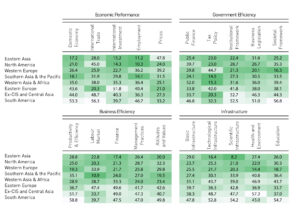
What is the competitiveness performance of the different regions in 2019?
On May 28, the IMD World Competitiveness Center launched the 2019 rankings. Singapore ranked as the world’s most competitive economy for the first time since 2010, Hong Kong remained in the second spot while the United States slipped from the top spot. The Press Release outlines the rankings for this year. In this edition of the Criterion of the month, we will sketch the performance of the regions.
Overall, while Eastern Asia tops the regional rankings, South America remains in the lowest position. Since 2016, Eastern Asian countries steadily improved from an average ranking position of 20 to about 17 in 2019. North America experienced a decline from an average position of 10 in 2015 to 22 in 2019. Western Europe remained stable (at about an average position of 21st) between 2017 and 2018, and it declined to about 23rd in 2019. The Southern Asia and the Pacific sub-region saw a decline in the 2017-2018 period but has increased from an average position of 29 in 2018 to about 25 in 2019. Western Asia and Africa experience the opposite trend increasing its average ranking (from about 34th to 33rd) from 2017 to 2018 and declining back to 34th in 2019. While Eastern Europe has steadily increased from 45th average position in 2017 to about 42nd in 2019, Ex-CIS and Central Asia economies declined from about 46th to 48th during the same period. The South American sub-region has steadily declined from 52nd in 2016 to an average ranking of 56th in 2019.
It is instructive to identify the performance of the sub-regions over the pillars of competitiveness. In fact, Table 1, provides the ranking position of all the sub-factor categories. The highest-ranking position in each sub-factor is denoted by the darkest green and the lowest position by lightest green.

Table 1. Sub-regional competitiveness average ranking positions, sub-factor level
The economic performance factor provides a macroeconomic evaluation of the domestic economy, employment trends and prices. Within this factor, Eastern Asia leads in the domestic economy sub-factor followed by Southern Asia and the Pacific, and North America. Eastern Europe tops the international trade sub-factor and Western Europe comes second. North America leads in the international investment and employment followed in both sub-factors by Eastern Asia. The prices sub-factor is led by Eastern Europe.
The government efficiency factor assesses the extent to which government policies are conducive to competitiveness. Southern Asia and the Pacific sub-region ranks at the top in public finance and tax policy with Eastern Asia in second in finance and, Western Asia and Africa second in tax policy. Western Europe tops the institutional and societal framework rankings followed by Eastern Asia in both sub-factors. Western Europe also leads in business legislation with North America coming in second and Southern Asia and the Pacific third.
In turn, the business efficiency factor quantifies the extent to which the national environment encourages enterprises to perform in an innovative, profitable and responsible manner. Western Europe ranks highest in productivity and efficiency, followed by North America and Eastern Asia. Southern Asia and the Pacific rank highest in the labour market, and Attitudes and values sub-factors. While in the former, North America comes second and Eastern Asia third; in the latter sub-factor, Eastern Asia comes second and Western Asia and Africa third. In the finance sub-factor, it is Eastern Asia that reaches the highest average position, followed by North America and Western Europe. Finally, Western Asia and Africa tops the management practices sub-factor, with Western Europe second and Eastern Asia third.
The fourth pillar of competitiveness relates to infrastructure and measures the extent to which basic, technological, scientific and human resources meet the needs of businesses. In this factor, North America is highest in the basic infrastructure sub-factor. Eastern Asia dominates the Technological and Scientific infrastructure sub-factors with Western Europe coming second and North America third in both sub-factors. Similarly, Western Europe leads the health and environment, and education sub-factors with North American second in the former, and Eastern Asia second in the latter sub-factor.
The highest sub-factor average position of the Ex-CIS and Central Asia sub-region is in tax policy, and the lowest in health and environment. South America reaches its highest position in the prices sub-factor and its lowest in the productivity and efficiency sub-factor.
This past year, global markets were characterized by high uncertainty because of changes in the international political landscape as well as trade relations. Countries chose different paths to address these challenges. Yet, from our research as well as the table above, the quality of institutions and the strength of societal values are ingredients that describe the competitive economies and portray the regions as well.
Research Information & Knowledge Hub for additional information on IMD publications
IMD produces a yearly Smart City Index offering a balanced focus on economic and technological aspects of smart cities on the one hand, and “humane dimensions” of smart cities (quality of life, environment, and inclusiveness) on the other. In this...

The European Commission is once again focused on boosting Europe’s competitiveness, this time by integrating the bloc’s capital markets. The EU executive published a range of measures on March 19, aimed at unlocking the €11.6 trillion ($12.8 trill...
We extend the mixed gamble perspective to explain how family-controlled firms frame and evaluate the difficult trade-off between potential gains and losses in financial wealth (FW) and socioemotional wealth (SEW) when pursuing portfolio-level stra...
Foreign firm access to the public procurement markets—valued at some $13 trillion worldwide—is not governed by standard trade policies and multilateral trade accords. In trade policy circles, failure to publish procurement tenders in a global lang...
With stagnant import volumes since 2021, and import prices at levels below those suggested by fundamentals, foreign exporters face an uphill battle to convert access to the Chinese market into revenues. Notably, the volume stagnation predates the ...
Published by International Institute for Management Development ©2025
Research Information & Knowledge Hub for additional information on IMD publications
Research Information & Knowledge Hub for additional information on IMD publications
IMD World Competitiveness Center Report, 8 April 2025
Research Information & Knowledge Hub for additional information on IMD publications
Research Information & Knowledge Hub for additional information on IMD publications
in Journal of Management Studies 20 March 2025, ePub before print, https://doi.org/10.1111/joms.13218
Research Information & Knowledge Hub for additional information on IMD publications
Research Information & Knowledge Hub for additional information on IMD publications
Research Information & Knowledge Hub for additional information on IMD publications
in The Quarterly Review of Economics and Finance January 2025, vol. 99, 101898, https://doi.org/10.1016/j.qref.2024.101898
Research Information & Knowledge Hub for additional information on IMD publications
Research Information & Knowledge Hub for additional information on IMD publications
Research Information & Knowledge Hub for additional information on IMD publications





